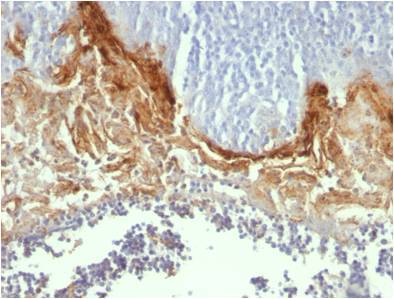Cat. #151163
Anti-Involucrin [SY5] mAb
Cat. #: 151163
Sub-type: Primary antibody
Unit size: 100 ug
Availability: 3-5 days
Target: Involucrin
Class: Monoclonal
Application: IF ; FACS ; IHC ; IF ; IP ; WB
Reactivity: Dog ; Human ; Pig ; Primate
Host: Mouse
£300.00
This fee is applicable only for non-profit organisations. If you are a for-profit organisation or a researcher working on commercially-sponsored academic research, you will need to contact our licensing team for a commercial use license.
Contributor
Inventor: Fiona Watt
Institute: Cancer Research UK, Lincoln's Inn Fields Institute
Primary Citation: Hudson et al. 1992. Hybridoma. 11(3):367-379. PMID: 1500072.
Tool Details
*FOR RESEARCH USE ONLY (for other uses, please contact the licensing team)
- Name: Anti-Involucrin [SY5] mAb
- Alternate name: Anti-Involucrin; involucrin antibody
- Cancer: Skin cancer
- Cancers detailed: Skin cancer
- Research fields: Cancer;Cell signaling and signal transduction
- Clone: SY5
- Tool sub type: Primary antibody
- Class: Monoclonal
- Conjugation: Unconjugated
- Molecular weight: 66-170 kDa
- Strain: Balb/c
- Reactivity: Dog ; Human ; Pig ; Primate
- Host: Mouse
- Application: IF ; FACS ; IHC ; IF ; IP ; WB
- Description: Clone SY5 recognises a protein of 66kDa-170kDa, identified as involucrin. Involucrin is a protein precursor of the epidermal cornified envelope and a differentiation marker of human keratinocytes. Involucrin expression is altered in pathological conditions such as psoriasis and other benign epidermal hyperplasias. This mAb stains the involucrin in a variety of sizes: 170kDa in MCF-7 cells, 66kDa in dog, and a doublet of 105kDa in pig. It's epitope maps between codon 421-568 of human involucrin. SY5 is useful for studies of changes in involucrin expression in pathological studies.
- Immunogen: Purified involucrin from human keratinocytes.
- Isotype: IgG1 kappa
- Myeloma used: P3X63Ag8
- Recommended controls: MCF-7 cells. Localized to upper spinous and granular layers in normal skin.
Target Details
- Target: Involucrin
- Molecular weight: 66-170 kDa
- Tissue cell line specificity: MCF-7 cells. Localized to upper spinous and granular layers in normal skin.
- Target background: In Western blotting of cultured human keratinocytes, this MAb reacts with a 120kDa protein. It stains the involucrin in a variety of sizes: 170kDa in MCF-7 cells, a doublet of ~115kDa and 150kDa in gorilla and owl monkey, 66kDa in dog, and a doublet of 105kDa in pig. Its epitope maps between codon 421-568 of human involucrin. Involucrin is expressed in a range of stratified squamous epithelia, including the cornea, which lacks a distinct cornified layer. In normal epidermis, it is first expressed in the upper spinous layers, and in keratinocyte cultures, all cells that have left the basal layer express it.Involucrin is a protein precursor of the epidermal cornified envelope and a differentiation marker of human keratinocytes. SY5 is useful for studies of changes in involucrin expression in pathological studies. Involucrin expression is altered in pathological conditions: in psoriasis and other benign epidermal hyperplasias, involucrin expression begins closer to the basal layer than normal; expression is abnormal in squamous cell carcinomas and premalignant lesions, and is reduced in severe dysplasias of the larynx and cervix.
Applications
- Application: IF ; FACS ; IHC ; IF ; IP ; WB
Handling
- Format: Liquid
- Concentration: 1 mg/ml
- Unit size: 100 ug
- Storage buffer: PBS with 0.02% azide
- Storage conditions: -15° C to -25° C
- Shipping conditions: Shipping at 4° C
Related Tools
- Related tools: Anti-Involucrin, Recombinant [SY5]
References
- Zhong et al. 2016. Cell. 167(1):187-202. PMID: 27662089.
- Morales et al. 2016. Toxicol In Vitro. 36(8):89-96. PMID: 27448499.
- Raj et al. 2016. Int J Cosmet Sci. 39(1):2-10. PMID: 27079667.
- Golinski et al. 2015. Cells Tissues Organs. 200(3-4):227-239. PMID: 26303436.
- Ravindran et al. 2015. Head Neck. 37(7):982-993. PMID: 24700702.
- Creppe et al. 2012. Mol Cell Biol. 32(8):1442-1452. PMID: 22331466.
- White et al. 2010. J Immunol. 185(8):4769-4776. PMID: 20861360.
- Skoog et al. 2009. J Invest Dermatol. 129(1):119-130. PMID: 18633436.
- Hudson et al. 1992. Hybridoma. 11(3):367-379. PMID: 1500072.



